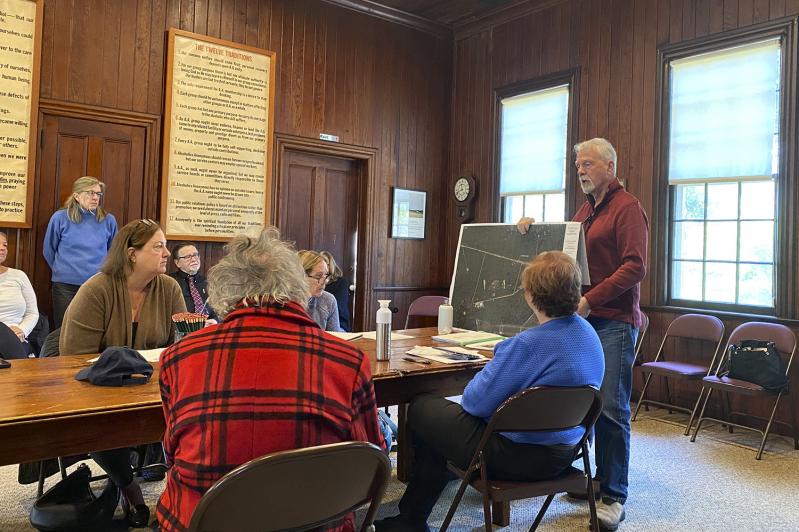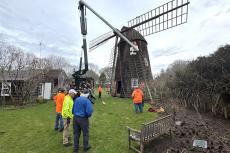Even though the East Hampton Town attorney said last month that the town could not entertain other offers on the 97-acre Wainscott property leased by the Maidstone Gun Club, a new suitor emerged on Saturday, this one with a proposal to develop a portion of the lot into privately owned affordable housing.
Speaking to the Wainscott Citizens Advisory Committee, Kirby Marcantonio, the leader of the consortium Whalebone Workforce Housing, said that the gun club parcel is one of few remaining in East Hampton that could be suitable for housing essential workers. He laid out his plan: 20 1,500-square-foot houses in the property’s northeast corner — set on 20 of its 97 acres — which would be exclusively sold to “essential workers,” such as teachers, police, and health care personnel. The houses would be listed for $600,000 to $700,000.
In October, the Coalition to Transform East Hampton Airport submitted a separate rental bid to the town for the land, which the Maidstone Gun Club has been leasing for 40 years at a rate of $100 per month.
The 30-year lease, which was a continuation of an original 10-year agreement, expired last October. The negotiation process, however, began on March 2, 2022, when the gun club notified the town of its intent to renew.
The coalition promised in its bid to exceed the unknown amount offered by the gun club in its renewal offer. (As for the amount, the town “expects to be in a position to make the terms public soon,” Town Councilwoman Cate Rogers said at the C.A.C. meeting.)
After that, the coalition planned to turn the site into an area for passive recreation that would be open to the public.
Mr. Marcantonio’s proposal to develop the land is separate from the coalition’s bid, though Mr. Marcantonio said that Barry Raebeck, the director of the coalition, expressed support for the initiative, as the development wouldn’t block “passive recreation” on the site.
As part of an agreement with the consortium, Mr. Marcantonio said, potential buyers would need to be first-time homeowners. Should the time come when they want to sell their house, it would need to be to other essential workers. In addition, buyers would be required to live in the houses, as opposed to renting them out to another party.
“I think the main idea is that 97 acres is a tremendous resource for the Town of East Hampton,” Mr. Marcantonio said at the meeting, adding that it is one of the largest properties in the town, besides the airport. Additional housing, he continued, would “be beneficial to the community at large.”
One question, Mr. Marcantonio said in a press release, “overshadows” the debate about the future of the gun club: “Should 97 acres of extremely scarce land be devoted to a single purpose no matter how constituted?”
At the meeting, he confirmed that his proposal could allow a “confined” gun range to continue operating, while also permitting additional uses for the property.
For the lease renewal more broadly, the town has not changed its stance; it plans to move forward with Maidstone Gun Club negotiations. Mr. Raebeck, who is also a member of the C.A.C., said on Saturday that he had not yet heard back from the town on his own bid.
“The town is negotiating a lease renewal with the club and expects to be in a position to make the terms public soon,” the town said in a statement, which Councilwoman Rogers read at the meeting. “The negotiated terms include security measures, increased rent, and other measures.”
Last month, East Hampton Town Police Chief Michael Sarlo also advocated for the gun club to remain, since his officers train at the facility. The next closest range is in Westhampton Beach, he said, and time constraints make it difficult for his officers to travel there for training. Chief Sarlo had nothing additional to add about the latest developments.
Anthony Liberatore, a member of the C.A.C., provided data on the environmental impact of a shuttered gun club in Buffalo at the meeting, drawing comparisons to the Wainscott institution. When the Buffalo gun club closed, the environmental cleanup took “a couple of years,” he said; 15,000 tons of soil were impacted by polycyclic aromatic hydrocarbons, a class of harmful chemicals. Of the 32 acres of land, 26 required cleansing. “Every single regulatory body that you can imagine was involved in this cleanup,” said Mr. Liberatore. The Buffalo gun range had been in operation for 60 years, while Maidstone Gun Club has occupied the Wainscott land for 40.
The point, Mr. Liberatore continued, is that the environmental impact of gun ranges is known, and the land will be “useless” for other purposes “until it is cleaned up.”
“Yet, the town seems to be completely blinded that this is potentially an issue,” he added. “I wonder if the motivation to rush into a lease is to push the problem another 30 years down the road.”
Mr. Liberatore then shifted to the safety issues brought by the gun club, and pushed back at the notion that shooting is part of the local culture. “There’s no culture in East Hampton to have a shooting range where people go with AR-15 rifles, violate rules, and are not supervised,” he said.
Mr. Raebeck echoed these sentiments, particularly the suspicion about the town’s motivation for continuing lease negotiations with the gun club.
“I’d like the town board to say publicly that this is the best use,” he said. “You’re not going to have any percentage of the town coming forward waving their rifles” to lobby for the gun club’s right to the land.
Future steps for Mr. Marcantonio’s plan will involve the East Hampton Town Board. The consortium leader notified the town of his proposal on Monday afternoon and plans to discuss it at a future board meeting.
This is not the first time that he has been involved in efforts to increase work force housing — a subset of affordable housing — in the area. In August, he was involved in a $5 million deal to buy a vacant parcel on Pantigo Road in East Hampton, where he is also proposing housing for local working people.




